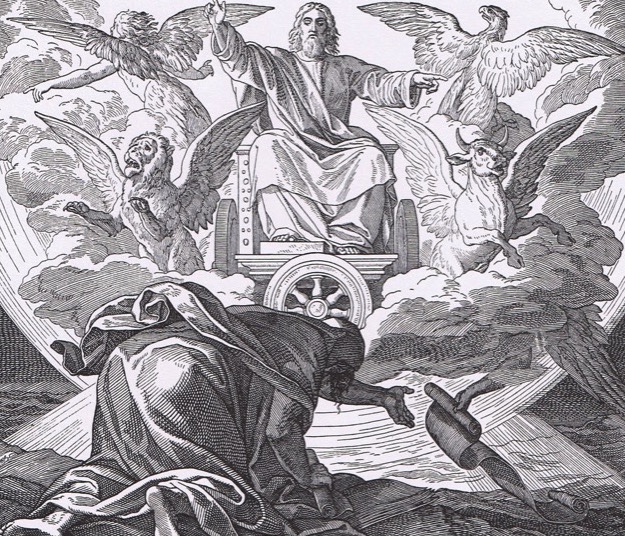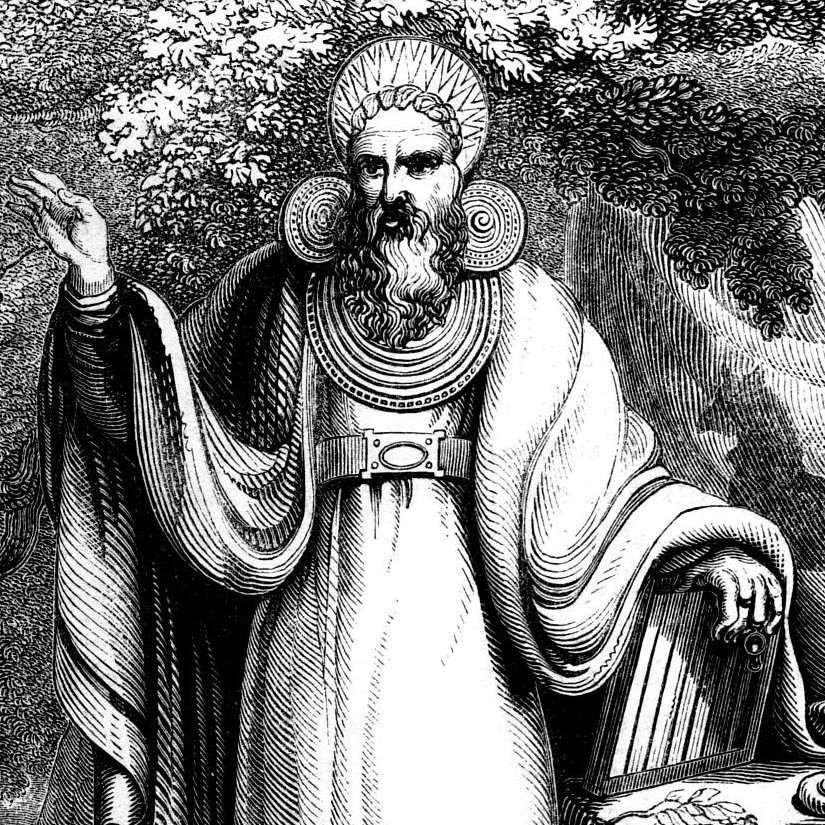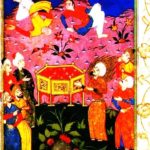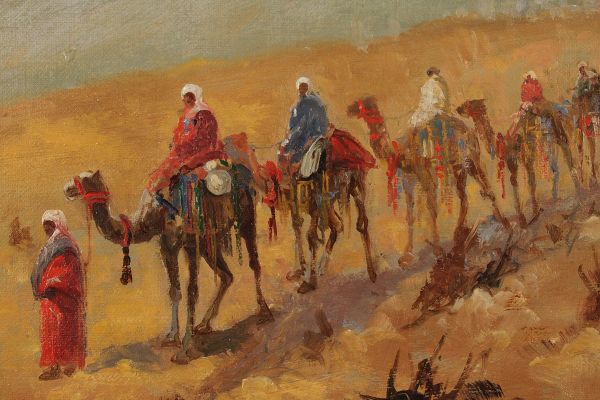If we recall, Muhammad’s first two revelations were only five short ayat each, and we should expect his next revelation not to be much longer.
I’ve explained why the traditional order for the surat is extremely unlikely on the main page about Surah 81. In short, we need Surah 81 to happen first to give the context for the people of Mecca to react to Muhammad in a way that could conceivably cause the events that some of the surat that are conventionally placed before Surah 81 are reacting to. In other words, Muhammad’s revelations can’t react to an event if that event doesn’t have any reason to have happened yet.
Putting Surah 81 here also puts the ayat about the throne and horizon near the actual vision of the throne in the horizon–which makes sense.
I’m further going to make a hypothesis that Surah 81 was revealed in three main phases, and that this was probably the first surah to be revealed in this way–context puts the additions to 74 and 96 later, because Muhammad should be getting external criticism by then and not merely doubting his own sanity, or else the ayat make no sense.
The First Revelation: the Great Day
First to be revealed would be most of the first sentence, of course:
- When the sun is wrapped up,
- And when the stars are poured out (of the sky),
- And when the mountains are moved away,
- And when the pregnant she-camels are abandoned,
- And when the wild beasts are gathered,
- And when the seas are aflame,
- And when the living beings are paired,
- And when the scriptures are unrolled,
- And when Heaven is stripped off,
- And when the Fire is set ablaze,
- And when the Garden is brought near,
- A person will know what he has brought.
This is 12 ayat, more than twice as long as the first two revelations, and it’s all tied together both in its literary form and in its subject, concluding only at the end of the last ayah.
This section here has some clear Christian imagery–quite strikingly from a harmonized synoptic Gospel is additional some fragmentary or tertiary sources, like Aramaic hymns dealing with the same subject. Waraqah’s influence here and in the next surah revealed is startling–and then, just as startling, is the long drought without any revelation that shows knowledge of any Christian, Jewish, or even traditional pagan sources.
Here is the relevant section from the real Gospel of Matthew:
29 “Immediately after the tribulation of those days the sun will be darkened, and the moon will not give its light, and the stars will fall from heaven, and the powers of the heavens will be shaken. 30 Then will appear in heaven the sign of the Son of Man, and then all the tribes of the earth will mourn, and they will see the Son of Man coming on the clouds of heaven with power and great glory. 31 And he will send out his angels with a loud trumpet call, and they will gather his elect from the four winds, from one end of heaven to the other. …
37 For as were the days of Noah, so will be the coming of the Son of Man. 38 For as in those days before the flood they were eating and drinking, marrying and giving in marriage, until the day when Noah entered the ark, 39 and they were unaware until the flood came and swept them all away, so will be the coming of the Son of Man….
Matthew 24, ESV
Let’s look at the sequence: the sun darkened, the stars fallen/poured out, and something scary happening in the heavens. Even “the living beings are paired” and “the wild beasts are gathered” has its source–that is, that’s the Quran’s interpretation of “as were days of Noah”: the gathering of the animals as if to go on an ark. The Quranic insistence on “pairs” of creatures (which will be referenced in other ayat, too) is quite odd, unless you have this context for this. Some translators have tried to twist the Arabic to make the verse about living beings being paired up into something about judgement of the good and evil, but that is simply not in the text.
There is also a mention of the sea, which doesn’t appear in Matthew but does appear in Luke and would also show up in a harmonized gospel:
25 “And there will be signs in sun and moon and stars, and on the earth distress of nations in perplexity because of the roaring of the sea and the waves, 26 people fainting with fear and with foreboding of what is coming on the world. For the powers of the heavens will be shaken. 27 And then they will see the Son of Man coming in a cloud with power and great glory.
Luke 21:25-27, ESV
Another really significant word is in Luke, and that is “signs.” An “ayah” is a sign, not a verse, properly speaking. Through his revelations, Muhammad is giving signs to the people in at the End of Days.
There’s also things from of the Book of Revelation here, with what seems to be the unrolling of a scroll and a lake of fire. The advance of the Garden–that is, Paradise–is also notable here. It’s hard to know if this came from a source or is original, but everything else is derivative of Christian scriptures, even down to the order of a harmonized gospel in the beginning followed by references to Revelation.
If Muhammad knew a fragment of something that originally came from this section of a harmonized gospel, he would not understand the reference to the Son of Man, and he would believe, if he knew this was Jesus being referenced, that it was a declaration that Jesus is nothing but a human prophet. However, this phrase is used here to mean something very different, from a vision of Daniel related in Daniel 7:
13 “I saw in the night visions,
Daniel 7, ESV
and behold, with the clouds of heaven
there came one like a son of man,
and he came to the Ancient of Days
and was presented before him.
14 And to him was given dominion
and glory and a kingdom,
that all peoples, nations, and languages
should serve him;
his dominion is an everlasting dominion,
which shall not pass away,
and his kingdom one
that shall not be destroyed.
It was known from ancient times that the one “like a son of man” was not, in fact, a mere human being, because otherwise, Daniel would have just said “a man.” (The Ancient of Days is God–or God the Father, of course.) Jesus, then, is the on appearing as a son of man in Daniel–the one to whom all dominion will be given. But Muhammad would not know that. He was, after all, an illiterate.
There’s no evidence that Muhammad knew about Jesus at all at this point by any name, despite the fact that Waraqa is called a Nazarene. It will be quite a bit later when someone seems to point out to him that the “prophet” of the Christians isn’t just a prophet but the Son of God or when he shows any specific knowledge of Jesus at all, and longer still before he gets a name for Jesus via the Jews.
But if he had heard something from this section of a harmonized gospel and later heard that Jesus–or “Isa”–would be coming as the Son of Man on the Great Day, he would certainly think that Jesus was indisputably human instead of indisputably being called something much more than human. And if Muhammad had this much of a gospel and nothing more, he would be absolutely confident about that what the Quran says about Jesus’ divinity would be found in the Injil or Gospel–and exactly, precisely backwards!
So far, then, we have a “tale of the ancients” prophesying the End of Days, or the Great Day, and both Christian sources often called the Second Coming of Christ. We also have judgement and a coming kingdom (or in this case a garden)–but not a resurrection. A resurrection takes a long time to penetrate the Quran, and when it does, Muhammad has to defend it.
Goodness knows why Muhammad thought that “as were the days of Noah” would mean that animals would all get paired up again, but apparently, that’s exactly what he thought.
With all of these things swarming in his head from time he had spent with Waraqah, he sought a revelation–which is just what he got.
The last ayah is just as murky in Arabic as it is in English. What can a person be expected to bring on the last day? The oddness of the verb here is striking, and it seems to be an artifact of the rhyme rather than a particularly meaningful choice, but it does still call to mind a final judgement on the Great Day.
This now gives Muhammad’s critics a basis for claiming that he is “repeating the tales of the ancients.”
The only thing I’ve omitted from this section is the couplet about infanticide, which doesn’t fit here, in a literal sense. It was likely an early addition, since infanticide is part of what’s probably the first creed of Islam:
Narrated Ubada ibn as-Samit [who was with the first group of Ansari converts of Medina]:
I gave the pledge of allegiance to the Prophet (ﷺ) with a group of people, and he said, “I take your pledge that you will not worship anything besides Allah, will not steal, will not commit infanticide, will not slander others by forging false statements and spreading it, and will not disobey me in anything good. And whoever among you fulfill all these (obligations of the pledge), his reward is with Allah. And whoever commits any of the above crimes and receives his legal punishment in this world, that will be his expiation and purification. But if Allah screens his sin, it will be up to Allah, Who will either punish or forgive him according to His wish.”
Sahih Bukhari 6801
Despite the early date of the command against infanticide, the couplet is out of place, both thematically and poetically, in this section and was probably revealed as the last ayat of the surah, maybe some time after other surat were revealed, but definitely while still at Mecca.
The Second Revelation: The Throne Vision
The second section that was revealed was probably this:
- But nay! I swear by the retreating ones,
- The sailing ones, the disappearing ones,
- And the night when it dissipates,
- And the dawn when it breathes,
- [That] indeed, it is surely a Word of a noble Messenger,
- Having power, secure before the Owner of the Throne–
- One obeyed there, trustworthy.
All of the “ones” are stars or planets. Here, the author, presumably Allah, is swearing by stars or planets and the dawn and the night–something very strange for the One God to do, but “swearing by” action would have been very common in Muhammad’s cultures for humans to do.
Here we have a reference to the Throne, one of two in the Quran–this is, clearly, Allah’s throne, and (despite different later attempts at reinterpretation) Muhammad is quite definitely the Messenger, because only human prophets are given this title in the Quran.
Everyone agrees that this is a very early surah. This places the surah in very close proximity to the throne vision that was the trigger for the first part of Surah 74. This presents a massive problem with the attempt to reinterpret the vision as Jibril sitting on a throne because 1) angels don’t sit on thrones, and 2) no one attempts to claim that the figure on the throne is not Allah in Surah 81, because that would clearly be blasphemy. The figure on the throne in Muhammad’s vision could only have been Allah, later ret-conned to remove the embarrassing vision at a considerably later date to match with declarations that no human can see Allah and live.
As I’ve discussed before, the throne vision is a clear reference to Merkabah mysticism. Muhammad is therefore “repeating the tales of the ancients” by giving it here, again, but he’s also claiming a very extreme sort of mystical vision, which would leave him open to criticisms that he’s crazy or possessed.
The Third Revelation: Muhammad’s not Crazy
This links into what was probably the third revelation:
- And your companion is not jinn-possessed,
- And certainly he saw him in the clear horizon
- And he is not a withholder of the Unseen.
- And It is not the Word of outcast Satan.
- So where are you going?
- It is naught but a reminder to sentient beings,
- Unto whoever wills among you to go straight.
- Any you shall not will [thus] except that Allah wills [it]–Lord of the Sentient Ones.
Here are the first statements assuring both Muhammad and his followers that he isn’t possessed or insane–and tying to the throne very clearly here to the horizon vision. “I’m not crazy! I did see the throne on the clear horizon!” Very obviously, this is not about the Owner of the Throne above–who can’t possibly be angel.
I also strongly believe that the last ayah was added considerably later as Muhammad’s sense of determinism overcame his initial optimism. It’s just as overloaded with syllables compared to the rest of the surah in Arabic as it is in English. Ayah 28 had finished the complete thought, and 29 is sort of tagged on to the end as an extra conditional–people are no longer being exhorted to do right but are being sorted by Allah into the category of “unbeliever” and “believer,” through no will of their own. This means, also, that when the surah was in its intermediate form, the word Allah still hasn’t appeared once, not in a single revelation.
The throne vision was later ret-conned into being applied to Jibril, which then weirdly divided the Throne event from the horizon event, even though the two were simultaneous in the ahadith, thereby turning the Throne from a report of a vision to something abstract.
Here is the hadith that accomplishes the ret-conning–my guess is that Muhammad actually does change his claims about this surah after his ambition changed to be a warlord over a prophet:
I was resting at (the house of) ‘A’isha that she said: O Abu ‘A’isha (kunya of Masruq), there are three things, and he who affirmed even one of them fabricated the greatest lie against Allah. I asked that they were. She said: He who presumed that Muhammad (ﷺ) saw his Lord (with his ocular vision) fabricated the greatest lie against Allah. I was reclining but then sat up and said: Mother of the Faithful, wait a bit and do not be in a haste. Has not Allah (Mighty and Majestic) said:” And truly he saw him on the clear horizon” (Al-Qur’an, Surat at-Takwir, 81:23) and” he saw Him in another descent” (Al-Qur’an, Surat Najm 53:13)? She said: I am the first of this Ummah who asked the Messenger of Allah (ﷺ) about it, and he said: Verily he is Gabriel. I have never seen him in his original form in which he was created except on those two occasions (to which these verses refer); I saw him descending from the heaven and filling (the space) from the sky to the earth with the greatness of his bodily structure. She said: Have you not heard Allah saying: “Eyes comprehend Him not, but He comprehends (all) vision. and He is Subtle, and All-Aware” (Al-Qur’an, Surat al-An`am 6:103)? (She, i.e. ‘A’isha, further said): Have you not heard that, verily, Allah says: “And it is not for any human being that Allah should speak to him except by revelation or from behind a partition or that He sends a messenger to reveal, by His permission, what He wills. Indeed, He is Most High and Wise.” (Al-Qur’an, Surat ash-Shura, 42:51) She said: He who presumes that the Messenger of Allah (ﷺ) concealed anything from the Book of Allah fabricates the greatest lie against Allah. Allah says: “O Messenger, announce that which has been revealed to you from your Lord, and if you do not, then you have not conveyed His message. And Allah will protect you from the people. Indeed, Allah does not guide the disbelieving people.” (Al-Qur’an, Surat al-Ma’idah, 5:67). She said: He who presumes that he would inform about what was going to happen tomorrow fabricates the greatest lie against Allah. And Allah says “Say, ‘None in the heavens and earth knows the unseen except Allah , and they do not perceive when they will be resurrected.’” (Al-Qur’an, Surat an-Naml, 27:65).
Sahih Muslim 177 a
Missing Ayat
The missing part of the surah is the couplet about infanticide:
- And when the buried one is asked
- For what sin was she killed,
This many have been added before or after ayah 29 of the surah.
One hadith specifically narrates that this is the withdrawal method of birth control, but the feminine form of the word makes that a goofy interpretation by the rules of grammar unless this is being asked of seminal fluid (feminine) rather than a person (masculine). Muhammad later specifically said in multiple other traditions that he didn’t like birth control but he did not consider it infanticide, so I find that unlikely. The consensus view that this means a buried infant daughter is certainly the correct one.





